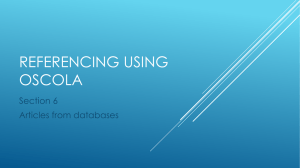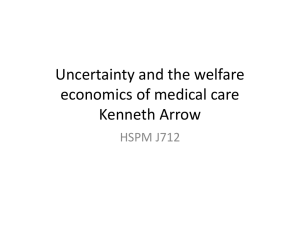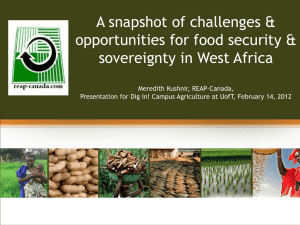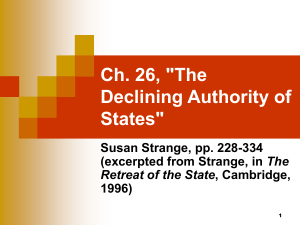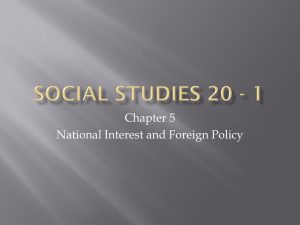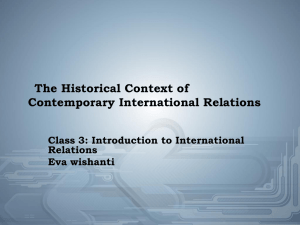Conceptions of Sovereignty in the US and EU and Foreign Policy
advertisement
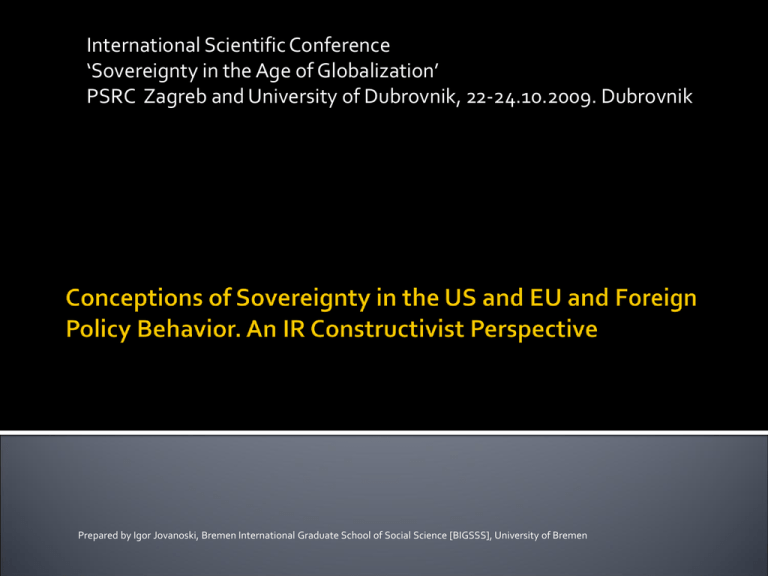
International Scientific Conference ‘Sovereignty in the Age of Globalization’ PSRC Zagreb and University of Dubrovnik, 22-24.10.2009. Dubrovnik Prepared by Igor Jovanoski, Bremen International Graduate School of Social Science [BIGSSS], University of Bremen The subject Why sovereignty and why US-EU Foreign policy behavior The concept of sovereignty A view from traditional IR A social-constructivist perspective on sovereignty Sovereignty and Foreign Policy Sovereignty in time Ideal sovereignty types Sovereignty in space Modalities for sovereignty translations through FP The US vs EU [France and Germany] sovereignty conceptions Sovereignty and Transatlantic Relations The recent Transatlantic Relations [TR] crisis prompted studies searching for the deeper, conceptual and empirical, sources behind the rift. Some invoked the concept of sovereignty (Keohane 2003, Anderson 2007). Its differing conceptualizations in the US and EU were seen as good indicators for the TR clash. This presentation takes up these issues into account. It briefly overviews mainstream, as well as IR constructivist perspectives on the theory of sovereignty, and following the last develops a framework for understanding translation of sovereignty into processes of Foreign Policy [FP] making and behavior. Lastly, it shows some empirical findings on the patterns of sovereignty in the US and EU [France and Germany] and presents some tentative assumptions on its effect on their respective FP behaviors in the recent TR rift “Definition” Sovereignty is a descriptive and prescriptive, legal, political, social and philosophical concept. It is the idea that legitimizes forms of supreme authority in a political community (Hinsley 1966). Rationalism Sovereignty is a legal and organizing principle; it is a historically fixed and static term that orders the relationships within state and among states. As such it is the feature all states posses and share (Waltz:1986) “To say that a state is sovereign means that it will decide for itself how it will cope with internal and external problems, including whether or not to seek assistance from others and in doing so limit its freedom by making commitments to them” (ibid.:90) Social constructivism Sovereignty is a socially constructed and discursively reproduced norm, constitutive of both state identity and the international society of states. It is a historical, time and space dependant rule, socially and culturally predetermined (Biersteker and Weber 1995, Biersteker 2002). Instead of a given, analytical category, the meanings of sovereignty are: Discursively negotiated out of interactions within intersubjectively identifiable communities, and, In the variety of ways in which practices construct, reconstruct and deconstruct sovereignty (Bierteker and Weber, 1995:11) Definition: For the rationalists, FP it is a strategic, rational state behavior aimed at protection of national interests; for constructivists it is also a normatively, identity driven behavior There are 3 ways for translating normative conceptions of sovereignty through FP: ▪ By constituting and shaping the agency and identity of the state ▪ Sovereignty practices shape state identity ▪ By constituting the national identity ▪ The discourse of sovereignty and the inside/outside boundary imposes fixed and stable meanings about who belongs and who doesn’t to the nation (Dotty 1995:122) ▪ By serving as social power in various FP contexts (Biersteker and Weber 1995, Philpot 2001) If analyzed historically, sovereignty practices as well as the discourse of sovereignty can be placed in 2 ideal types: Classical sovereignty* ▪ Statist and popular sovereignty Post-national sovereignty** ▪ Pooled ▪ Post-statist [or post-modern] ▪ Cosmopolitan Classical sovereignty conceptions Post-national sovereignty conceptions Core constitutive principles - sovereignty resides in the monarch, state or the nation - sovereignty is an absolute condition; - sovereignty is unitary; - sovereignty in non-transferable - Sovereignty keeps its classical locus of residence, but: - sovereignty is limited - it may be fragmented and delegated; - sovereignty is divided – it may be shared among sovereign/sub/supra national actors; - sovereignty is partial and transferable to institutions below and above state authority line Core regulative principles Exclusive and centralised control over territory, state autonomy and independent internal and external state policies, territoriality and inviolability of territorial integrity, Non-intervention Division and transfer of states’ competences, diffusion of power to regional, state or supra-national level, multilevel governance, multilateralism; Core normative principles Protection and provision of National Security, International order, Freedom, National Liberty, Justice and Welfare Democracy, human rights protection, individual liberties, legitimacy, welfare provisions, inter/transnational cooperation US conceptions of sovereignty Classical ▪ Popular ▪ Rooted in the historical processes of the constitution of the American polity ▪ Constantly constitutive of the US exceptionalism discourse ▪ Statist ▪ Also historicaly present in the formative processes, in the struggle between the former colonies and the newly established Federation ▪ Dominant as a form of statism in the US FP discourses from the end of the WWII onward and related to the prominence of the political realism theory EU conceptions of sovereignty Post-national ▪ Institutionally embedded in the EU and its respective policies ▪ Beyond sovereignty and EU integration [Germany] ▪ ‘le souverainisme’ contra ‘la souveraineté transféré’ and ‘partagée’ ▪ and France] Classical ▪ Staatssouveränität über alles [Germany] ▪ La Mal de Bodin Rousseau’s challenges ▪ Souveraineté nationale vs.Souveraineté populaire Transatlantic relations as a social, political, military and economic order Material factors matter Normative factors such as conceptions of sovereignty have deep impact on the TR FP Relations Anderson, Jeffrey, Ikenberry, George and Risse, Thomas. 2009. The End of the West? Crisis and Change in the Atlantic Order. Cornell University Press. Biersteker, Thomas and Weber, Cynthia. 1995. State Sovereignty as Social Construct. Cambridge Studies in International Relations Burchill, Scott et all. 2003. Theories of International Relations. Palgrave Macmillan Checkel, Jeffrey T. 1998. The Constructivist Turn in IR. World Politics 50 , 324-48 Hinsley, F.H. 1986. Sovereignty, 2nd ed. Cambridge: Cambridge University Press Keohane, Robert O. 2002. Ironies of Sovereignty: the European Union and the United States, Journal of Common Market Studies 40, pp. 743-760. Krasner, Stephen D. 1999. Sovereignty: Organized Hypocrisy. Princeton: Princeton University Press. Ruggie, John G. 1998. Constructing the World Polity. Essays on International Institutionalisation. Routledge Waltz, Kenneth. 1986. Political Structures, in: Keohane, Robert O. (ed.), Neorealism and Its Critics, New York: Columbia University Press, 1986, p.90. Byers, Michael & Sinclair, Adriana (2006) When US scholars speak of ‘sovereignty’, what do they mean? ‘Sovereignty, the State and Fundamental Transformations in Public International Law’ TranState Project - University of Bremen, Germany
